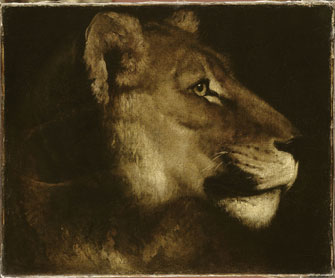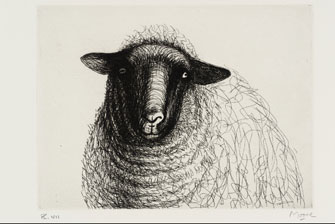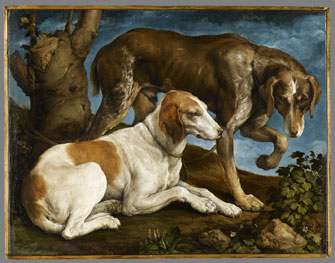A Feast of Beasts in
All-Animal Exhibition

Théodore Géricault’s “Head of a Lioness (c. 1819). © Service Presse, Réunion des Musées Nationaux-Grand Palais/Christian Jean
If you love animals (or at least pictures of them) and you love art, it will be hard not to like “Beauté Animale: De Dürer à Jeff Koons” at Paris’s Grand Palais. Like most themed exhibitions of this type, it is not too intellectually challenging, and it offers many beautiful works of art and some commentary about the way animals have been depicted in the history of art, starting from the Renaissance, when artists first began to show them on their own rather than as adjuncts to humans. The exhibition contains only works starring animals – both wild and domesticated – sans people.
Albrecht Dürer is credited with inventing the animal study. A few of his almost tactile animal engravings are included in the exhibition, among them the famous heavily armored rhinoceros, an animal he had never seen, and a touching and highly naturalistic drawing of an elephant. Look closely at the Hans Hoffman painting of a hare, inspired by Dürer’s depiction of the animal, at the beginning of the show to make sure you don’t miss the cunning little fly hovering above the animal.
When artists began to take a serious interest in animals, their curiosity took a scientific turn, and they began to study the anatomy of various beasts and the ways they moved in the interest of depicting them correctly – the exhibition includes a number of these studies, including some of Eadweard Muybridge’s photographic series of animals in movement. In the realm of scientific investigation and realistic portrayals, we also have some of Jan Van Kessel’s famous insect studies, a gorgeous American flamingo in a large album by Jean-Jacques Audubon, and menageries painted by various artists as they excitedly explored never-before-seen animals brought back from foreign lands during the Age of Discovery.
Many other artists who had a special affinity with animals are represented in the show, among them Théodore Géricault (his beautiful proud and pensive “Lioness,” pictured above, horses and more), Edgar Degas (expressive horse sculptures); sculptor François Pompon (whose marvelous massive streamlined polar bear ends the show).
Jeff Koons, though he merits a mention in the title of the show, is represented by only one work, an amusing, kitschy 1991 sculpture of a pampered poodle.
One of the many surprises – among them the work of Pompon, whom I didn’t know before –

“Head” (1974) by Henry Moore. © Tate, London 2011 Reproduced by permission of The Henry Moore Foundation
was a set of charming drawings of sheep by Henry Moore, better known for his monumental, near-abstract sculptures. Vincent Van Gogh is represented by a painting of a bat, of all things.
Among old favorites was what is supposedly the first depiction of dogs in their own right: Jacopo Bassano’s “Two Hunting Dogs Tied to a Stump” (1548-49), one lying down, eyes heavy

Jacopo Bassano’s “Two Hunting Dogs Tied to a Stump” (1548-49). © Service presse Réunion des Musées Nationaux-Grand Palais/Stéphane Maréchalle
with sleepiness, the other alert and protective, posed against a gorgeous blue sky. Another familiar work that it was a pleasure to see again was Gustave Courbet’s “Trout” (1873), the bleeding fish on a line apparently a metaphor for his situation after being exiled to Switzerland because of his revolutionary activities during the Paris Commune.
Like everything else, the exhibition points out, animals go in and out of style. The cat, for instance, so adored and over-depicted today, was once feared and despised as a symbol of vice. Here we have Goya’s savage fighting cats; Manet’s stylized rooftop cats, one black, one white, Giacometti’s skinny stretch cat; and Bonnard’s wonderful elongated, self-pleased cat.
Go and feast your eyes on all these beasts just for the sheer pleasure of it.
Galeries Nationales du Grand Palais: 3, avenue du Général Eisenhower, 75008 Paris. Métro: Champs-Elysées Clemenceau. Tel.: 01 44 13 17 17. Open Wednesday -Monday, 10am-8pm; until 10pm on Thursday. Admission: €12. Through July 16, 2012. www.rmn.fr.
Reader Reaction: Click here to respond to this article (your response may be published on this page and is subject to editing).
Please support Paris Update by ordering books from Paris Update’s Amazon store at no extra cost. Click on your preferred Amazon location: U.K., France, U.S.
More reviews of Paris art shows.
© 2012 Paris Update
